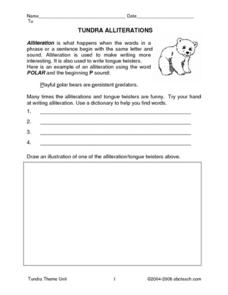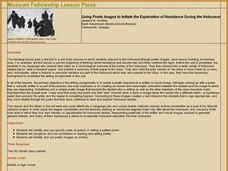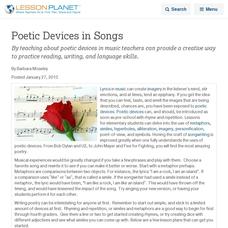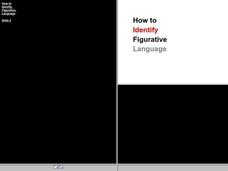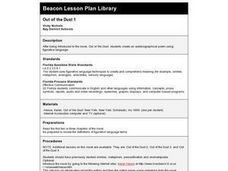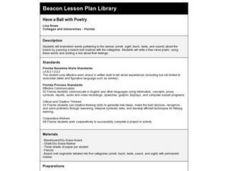Curated OER
Arctic Alliterations
In this poetry worksheet, students read a description of an alliteration with an example. Students practice writing alliterations with the help of a dictionary and illustrate one of their tongue twisters.
Curated OER
Using Poetic Images to Initiate the Exploration of Resistance During the Holocaust
Students explore the role of resistance during the Holocaust. Viewing images, they complete a set of notes on the Holocaust and discuss the feelings they get from looking at the photographs. They identify the parts of speech used in...
Curated OER
Poetry
Sixth graders research famous poets. In this poetry lesson, 6th graders investigate poets and discover their famous literary works. Students conduct research using Internet resources and prepare a presentation.
Teachers.net
Figurative Language
When is a staple remover a fanged monster? In your ELA classroom when you're teaching this fun figurative language instructional activity, of course! Get your young writers using figurative language by making a game of it. Give groups a...
New Vista Middle School
Hyperboles
Turn hyper bowls into hyperboles that will take away the breath of your principal and learners with the knowledge available in this presentation. The PowerPoint provides very clear and accurate information that breaks down how hyperboles...
Curated OER
Poetic Devices in Songs
By teaching about poetic devices in music teachers can provide a creative way to practice reading, writing, and language skills.
Curated OER
Identifying Figurative Language #1
In this identifying types of figurative language instructional activity, students read sentences and phrases, determine if they are similes, metaphors, hyperboles, personifications, or a combination, identify the type/s and write an...
Curated OER
The Language of Surprise
Aspiring writers complete and discuss fill-in-the-blank cliché expressions, define cliché as a form of predictable writing, take cliché expressions and turn them into new, unpredictable ones, read poetry that illustrates writer's use of...
Curated OER
Rain Forest Alliterations
The rain forest alliterations activity has students read about alliterations, then complete 4 alliterations about the rain forest and draw an illustration of one of them. The close with an acrositc poem with the words "rain forest."
California Academy of Science
Poetic Reflections
Poetry is a wonderful way to explore language, express topical understanding, and incite creative thinking. After a trip to the local natural history museum (or zoo), learners write an acrostic or a cinquain poem describing one of their...
Gwinnett County Public Schools
Analysis of the Tuck Everlasting and The Birchbark House Text Exemplars
Looking to introduce some text-based questions into your ELA lessons? Practice the kinds of skills the Common Core demands with the seven text-based questions and the essay prompt provided here. Designed to be a three-day lesson, day one...
Curated OER
Comments WERD
Students examine several examples of similes and metaphors, stating what is being compared. Then each student chooses a different person from the Civil War era and writes similes and metaphors that describe that person.
Curated OER
How To Identify Figurative Language
Students investigate writing techniques by analyzing a chart. In this figurative language lesson, students define similes, metaphors and identify the difference between them and personification. Students demonstrate their understanding...
Curated OER
The Odyssey Plan
Ninth graders read and analyze The Odyssey. They apply note-taking skills to identify enemy, type of enemy, and traits demonstrated throughout the book. Students create a storyboard that illustrates the selected episode from the book...
Curated OER
Out of the Dust 1
Pupils review figurative languages terms and examples. They read the first entry in the book, Out of the Dust, and discuss the images created by the author. Then they create an autobiographical poem using figurative language.
Curated OER
Reading Lesson Plan
Tenth graders read the poem "Still I Rise" and discuss the different ways it can be told and read and brought to life. In this poetry lesson plan, 10th graders read aloud and silently, and compare different works of poetry.
Curated OER
Have a Ball with Poetry
Second graders brainstorm words pertaining to the senses about the beach. They write a free verse poem, using these words and adding a line about their feelings.
Curated OER
The Nature of Haiku Poetry
Students brainstorm elements of nature art prints and photos. They identify the syllable count of Haiku and take a nature walk. They write Haiku poems while practicing the use of simile, alliteration, metaphor, and analogy to describe...
Curated OER
Still I Rise: Maya Angelou
Students read the poem, Still I rise, by Maya Angelou. They examine how language, poetic devices, and format contribute to the poet's message. They identify poetic devices used in the poem.
Curated OER
Troublesome Word Rap
Create songs and raps to develop an understanding of the proper use of common misused words and homophones. First, your class defines misused words and homophones correctly by utilizing the words in a rap or song. Then they use poetry...
Curated OER
Original Line or Familiar Find?
Students examine a primary source document from 1684 that includes many of the same lines found in Romeo's speech to Juliet from Shakespeare's Romeo and Juliet. Students compare the texts and discuss authorship during the sixteenth and...
Oklahoma State Department of Education
Sandwich Feast
Creative! Youngsters listen to the reading of "Recipe for a Hippopotamus Sandwich" by Shel Silverstein as a warm up activity for a lesson in punctuation. They use bread-shaped pages, one for each type of punctuation, to identify which...
Curated OER
Figurative Language #2
Identify figurative language in sentences that have been pulled out of a text. Looking at the sentence independently, can you tell which technique is being used? How do you know? Ninth graders look at 10 sentences that show simile,...
Curated OER
A Simile and Metaphor Lesson
Pupils use their knowledge of similes and metaphors to analyze poetry. For this poetry and language lesson, students read examples of similes and metaphors and write their own examples that describe their city, television, or an era in...


